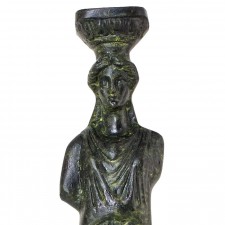Η καρυάτιδα του Ερέχθειου, στην Ακρόπολη
Η καρυάτιδα είναι μια γυναικεία φιγούρα που χρησιμοποιούνταν αντί για κολώνα. Οι πιο διάσημες είναι οι 6 καρυάτιδες του Ερέχθειου, στην Ακρόπολη.
Χειροποίητο ορειχάλκινο γλυπτό, με εγγύηση ποιότητας. Παραδοσιακά φτιαγμένο με τη μέθοδο χύτευσης μετάλλου και με οξείδωση παρόμοια με του μουσείου.
Καρυάτις ονομάζεται το γλυπτό που έχει γυναικεία μορφή και χρησιμεύει στην στήριξη κτιρίων. Η λέξη Καρυάτις στα αρχαία Ελληνικά σημαίνει Κόρη από τις Καρυές, μια πόλη κοντά στην Σπάρτη. Είναι μια παραλλαγή της Κόρης και χρησιμοποιείται στην αρχιτεκτονική αντί για κίονες ως διακοσμητικό στήριγμα σε πύλες, προσόψεις, γείσα, ζωφόρους, σκεπές και λοιπά. Το αντίστοιχο αρχιτεκτονικό στοιχείο που έχει ανδρική μορφή ονομάζεται Άτλας. Στην αρχαία αρχιτεκτονική τέχνη, ιδίως στον Ιωνικό ρυθμό οι κίονες συχνά αντικαθίσταντο με αναπαράσταση λυγερής γυναικείας μορφής. Στον Δωρικό ρυθμό αντίθετα, προτιμούσαν τα γεροδεμένα ανδρικά κορμιά.
Οι Καρυάτιδες έχουν τα χέρια ελεύθερα, ενώ το βάρος στηρίζεται απλά και ανάλαφρα με το κεφάλι. Οι Άτλαντες αντίθετα χρησιμοποιούν τους ώμους, την πλάτη και τα χέρια δίνοντας την εντύπωση ιδιαίτερου φόρτου βάρους. Η κλασική μορφή της Καρυάτιδας είναι ντυμένη με απλούς μα και κολακευτικούς πέπλους και χιτώνες. Έχει ευθύγραμμη και λυγερή κορμοστασιά, και τα πόδια ή κλειστά ή το δεξί ή το αριστερό πόδι ελαφριά εμπρός, χωρίς να βαδίζει. Τα χέρια είναι στο πλάι και προς τα κάτω, ενώ μερικές φορές στο ένα χέρι κρατούν ένα αφιέρωμα. Οι δίπλες στα ρούχα τους εναρμονίζουν με τα αυλάκια των κιόνων, κάνουν όμως παραλλαγές, καθώς ακολουθούν τις καμπύλες του σώματος. Οι Καρυάτιδες ήταν επιφανειακά ζωγραφισμένες στην αρχαία εποχή, αλλά τα χρώματα χάθηκαν με το πέρασμα του χρόνου.
Οι Καρυάτιδες στο Ερέχθειο της Ακρόπολης ανήκουν στην καλλιτεχνική σχολή του πλούσιου στιλ και επηρέασαν καλλιτεχνικά την αρχιτεκτονική διακοσμητική τέχνη μέχρι και το τέλος του 19ου αιώνα. Συχνά στοιχεία απομίμησης βρίσκουμε στον Μανιερισμό, καλλιτεχνική ροή του 16ου αιώνα.
Εκτός από το Ερέχθειο συναντάμε Καρυάτιδες το 525 π.Χ. στον απλό ναό του Θησαυροφυλακίου των Σιφναίων στους Δελφούς, όπου δύο Κόρες με ιωνική ενδυμασία στηρίζουν το αέτωμα. Καρυάτιδες επίσης βρίσκονταν και στα μικρά προπύλαια της Ελευσίνας. Οι δύο υπερμεγέθεις κόρες αντικαθιστούσαν τους κίονες. Μια από αυτές εκτίθεται στο μουσείο της Ελευσίνας ενώ η δεύτερη βρίσκεται στο Fitzwilliam Museum του Cabridge.
Στις 4 Σεπτεμβρίου 2014, ανακοινώθηκε από το Υπουργείο Πολιτισμού της Ελλάδας και δόθηκαν στη δημοσιότητα φωτογραφίες με δύο Καρυάτιδες στον δεύτερο προθάλαμο του τάφου στον λόφο Καστά στην Αμφίπολη.
Διαβάστε περισσότερα εδώ
| Λεπτομέρειες | |
| Ύψος | 11cm |
| Βάρος | 300g |
| Υλικό | Ορειχάλκινο |



